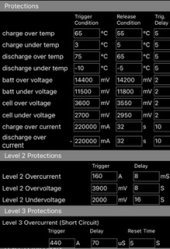MadMacks
Off Gridder
I have a JBD 4S 200 amp BMS (JBD-SP04S034-L4S-200A-H) that I recently installed as a replacement for a similar JBD 100 amp BMS because I was having issues in the winter when running my generator and charging and then having the sun come out and boost up the charge from my solar panels, tripping the 100 amp BMS. This solved the problem and I was regularly charging at 100-140 amps.
Now that summer is here I am using my power tools again but now, with the higher amp BMS I am tripping it and getting a "short circuit" fault and the BMS disconnects the battery from my inverter.
The exact same power tools. The exact same inverter. But it now trips at the BMS! What the heck! A higher capacity BMS and it's tripping?
Anyone have an idea as to why this is happening?
Now that summer is here I am using my power tools again but now, with the higher amp BMS I am tripping it and getting a "short circuit" fault and the BMS disconnects the battery from my inverter.
The exact same power tools. The exact same inverter. But it now trips at the BMS! What the heck! A higher capacity BMS and it's tripping?
Anyone have an idea as to why this is happening?




